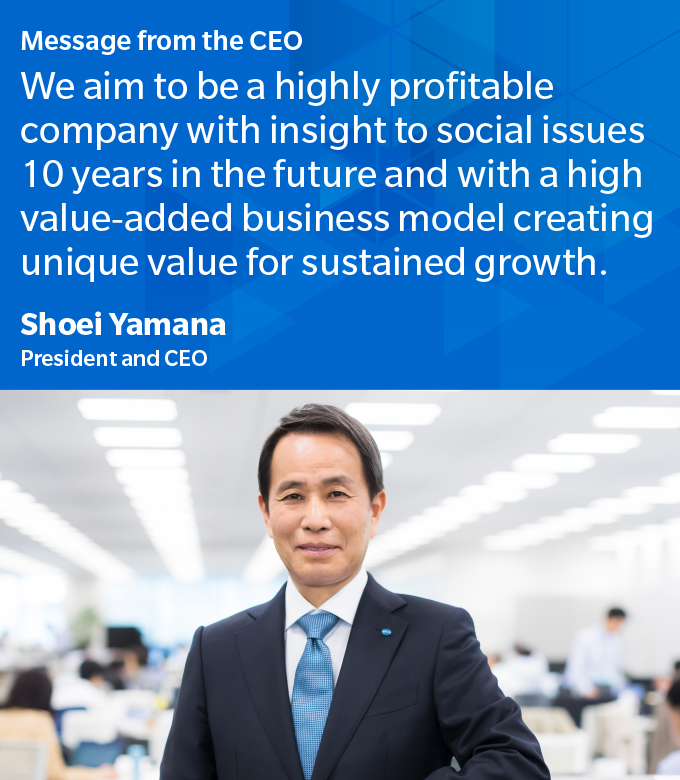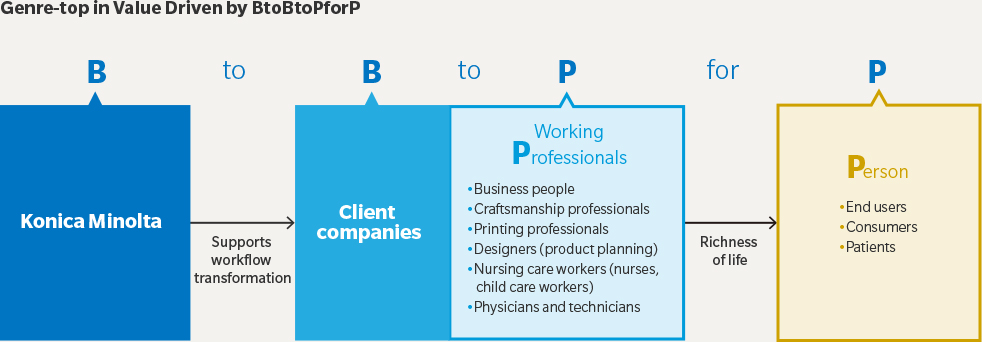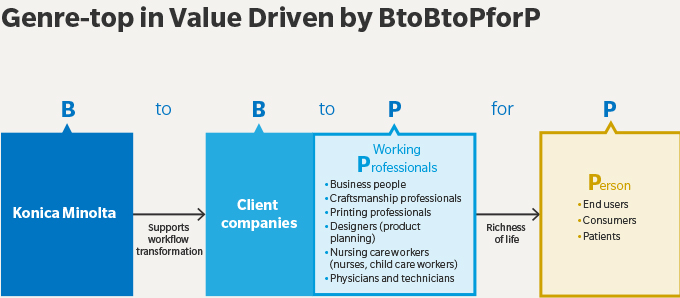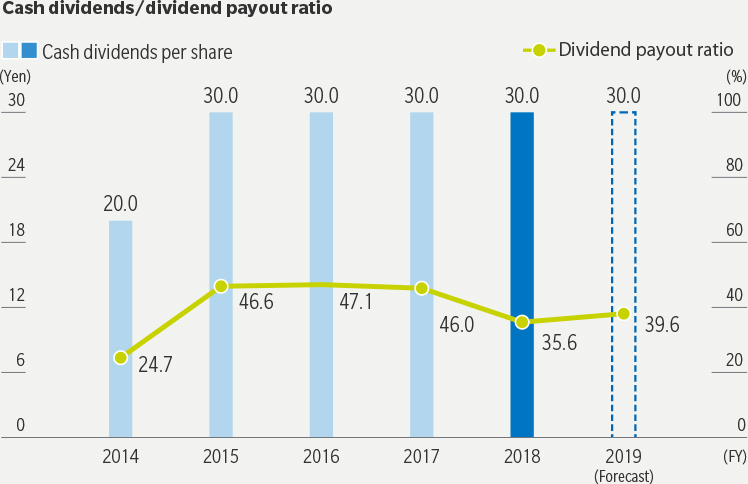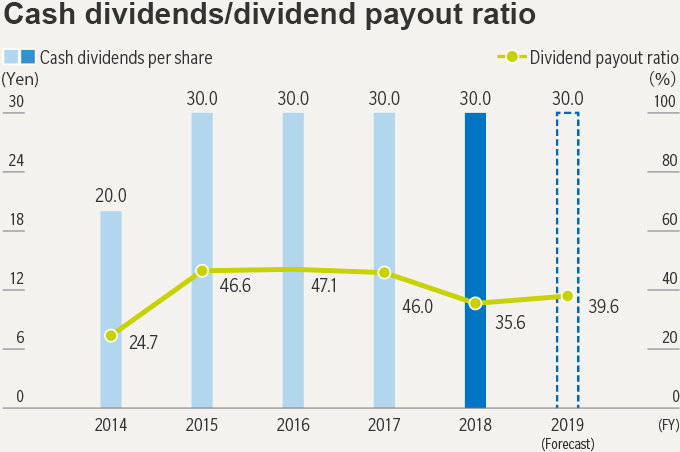Review of fiscal 2018 business results and progress of the SHINKA 2019 medium-term business plan High value-added sales boosted profitability in the core business
The Konica Minolta Group continued improving its revenue performance in fiscal 2018 with consolidated revenue growing 2.7% year on year to ¥1,059.1 billion. Factoring out the impact from foreign currency conversion, revenue in real terms grew by 4%. Profits were impacted by slower than expected progress bringing new businesses to profitability, but increased revenues in our core businesses and a higher gross margin from high value-added sales helped lift operating profit by 16.0% year on year to ¥62.4 billion and profit attributable to owners of the company by 29.3% year on year to ¥41.7 billion, our highest profit results since the 2008 financial crisis.
In fiscal 2017, the middle year in the three-year SHINKA 2019 medium-term business plan, management focused on two main areas: radically boosting the profitability of the core businesses and steadily growing business in new fields.
In the core Office and Professional Print Business, we raised our gross margin by working closely with our clients and proposing value-added solutions to qualitative issues in the workflows at their office sites. Particularly noteworthy in our business performance is the improvement in the operating profit ratio of the production print business unit to over 10% (see page 39).
We enhanced the earning power of the core businesses by quickly identifying business potential in the growth markets of China, India, and ASEAN countries and by persevering with investments in strategic regions. Our approach is to put great effort to understand regional cultures and analyze local market characteristics, and then to apply our insights to marketing and sales channel strategies. These efforts have helped us establish solid market positions and capture dominant market share surpassing 50% in some countries. We also augmented the earning power of our core businesses on the production side by overhauling our systems and incorporating digital manufacturing to boost quality and lower costs. I believe we achieved significant results.
As we transform our business portfolio, I believe it will be important to use our core businesses as cash cows and reinvest the profits to develop the new and growth businesses into new high-profit operations. We have had success with this approach in the Professional Print Business where we allocated profits earned in the Office Business to upfront investment in the production print business unit and built it into a high-profit operation. The current medium-term business plan designates the industrial printing business unit as a growth business, and we are presently aggressively investing in product development to fortify its product lineup and build our team of expert sales staff. The unit's sales are steadily expanding, although it will need more time to begin contributing significant profits. The IJ (inkjet) components unit of the Industrial Business is also steadily developing into a high-profit operation and is supporting the increasing competitiveness of the industrial printing business unit.
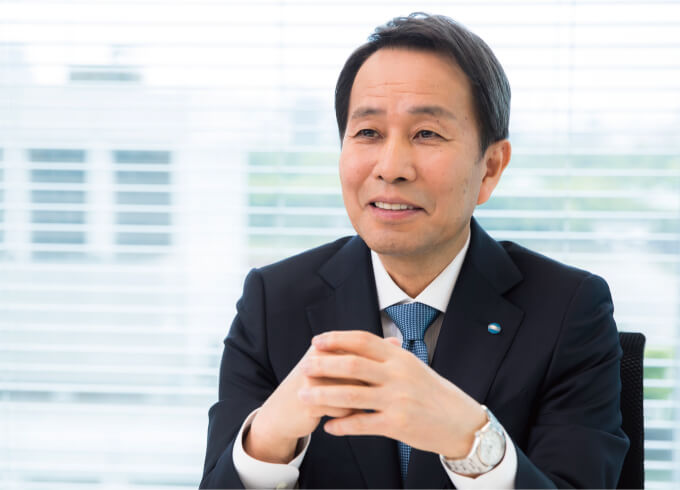
As anticipated, the customer value offered
by our new businesses is being eagerly received
The new businesses are taking longer than expected to reach profitability and there results fell short of our targets. Nevertheless we have made measurable progress in the past two years toward fulfilling the mandate of the medium-to-long-term view to develop new businesses into high-profit operations.
During the year, we launched sales of Workplace Hub, which is the centerpiece of our Edge IoT Platform, in Europe and the United States and achieved our first objective by garnering strongly positive responses for the platform's customer value (see page 31 for details). Although the launch was a year later than planned, our fully formed sales and service structure will enable us to expand the business as planned in various countries and cities. Workplace Hub has generated a superlative response not just from existing dealers in the sales channels but also from telecom firms, which creates potential for us to connect with strategic partners and also provides a sightline to becoming a Connected Office platform provider. Although we were slow to get started in fiscal 2018, we were able to lay the groundwork for the future. In fiscal 2019 we aim to reach 4,000 customers for the business, which is the one-year breakeven point, and steadily progress to our near-term target of a total of 10,000 customers in fiscal 2020.
Workplace Hub generates revenue per customer eight times higher than spending per MFP unit. It also brings longer contract periods and higher contract retention rates than for individual IT services. In addition, combining Workplace Hub with our MFPs can maximize customer lifetime value, enable us to transform the Office Business for future needs, and accelerate the growth in business scale.
In the growth field of precision medicine, we put in place the structure to advance synergy strategies by establishing a global headquarters for the bio-healthcare business in the United States in fiscal 2018 and unifying the operations with the two U.S. firms acquired in fiscal 2017 (see page 35 for details). The U.S. headquarters has established a Scientific Advisory Board chaired by a former head of the American Association for Cancer Research and with members who are key opinion leaders in the healthcare field. The advisory board will help the new operation formulate and advance highly effective business strategies.
In Japan, we established Konica Minolta Precision Medicine Japan and in the second half of fiscal 2018 began developing business providing drug development support, including for the Quanticellor High Sensitive Tissue Testing (HSTT). In June 2019, we announced an agreement with the University of Tokyo and the National Cancer Center Japan to jointly research and develop a next-generation oncogene panel test. The company is actively participating in the project to formulate a cancer genome medical care system for Japan.
The results for our new businesses in the past year have verified that the value these businesses are providing to customers is finding the eager markets that we anticipated. We will continue to monetize these businesses by formulating high-profit business models including subscription services and performance-based fee models. We will continue raising the high value-added in our products and services in all of our business areas, including operations like our core businesses where we have already established sound and profitable business models.
We will improve our profitability and
transform the profit structure in fiscal 2019
by enhancing the earning power of the core businesses and
expanding sales in the new and growth businesses
As stated above, in fiscal 2018 we made steady progress advancing the initiatives of the SHINKA 2019 medium-term business plan to enhance the earning power of the core businesses and expand sales in the new and growth businesses.
Looking ahead to fiscal 2019, the final year of SHINKA 2019, we anticipate a volatile external business environment that could change even daily as our customers restrain capital investment amid the trade friction between the United States and China, slowing economic growth in China, and lingering uncertainty about the European economy.
This outlook led us to lower our guidance for fiscal 2019, which we had announced in May 2019, at the close of the first quarter in June. We reset our forecasts for consolidated revenue to ¥1,085.0 billion (+2% year on year), operating profit to ¥60.0 billion (-4%), and profit attributable to owners of the Company to ¥37.5 billion (-10%).
Management takes very seriously the decision to lower fiscal year guidance from its initial estimates and the medium-term management targets. At the same time, the corporate real estate (CRE) strategy generated significant "other income" in fiscal 2018, and we estimate that, even after the guidance revision, real operating profit when factoring out such special circumstances will grow by roughly ¥10 billion. This indicates that the business's earning power is growing, and in fiscal 2019 we will continue pursuing the SHINKA 2019 strategies and pushing to transform our profit structure.
We will further advance strategies to enhance the earning power of the core businesses including developing, preparing to manufacture, and releasing a steady flow of new products that are user friendly and offer compelling quality for customers. In the new and growth businesses, management decided it is prudent to continue investing management resources aimed at generating growth in the medium- and long-term and diligently cultivate new high-profit businesses in each business field.
FY2019 Earnings Forecast
| Medium-term management targets (Billions of yen) |
Fiscal 2019 forecast (Billions of yen) |
Fiscal 2018 results (Billions of yen) |
YoY | |
|---|---|---|---|---|
| Revenue | 1185.0 | 1085.0 | 1059.1 | +2% |
| Operating Profit | 75.0 | 60.0 | 62.4 | -4% |
| Profit attributable to owners of the Company |
50.0 | 37.5 | 41.7 | -10% |
| ROE | 9.5% | 6.7% | 7.7% | -1.0pt |
FOREX [Yen]
| USD | 105.0 | 110.9 | ||
|---|---|---|---|---|
| EUR | 123.0 | 128.4 |
For medium- and long-term growth
An “autonomous and distributed solutions”
model for quick on-site issue resolution
The Company has been steadily evolving through the M&A and other measures undertaken since the launch of the previous medium-term business plan Transform 2016 to overhaul our business portfolio for the medium- and long-term and become "a digital company with insight into implicit challenges." From this point, we will start looking beyond the present plan to identify the emerging global trends.
While IT giants like GAFA (Google, Apple, Facebook, and Amazon) in the United States and BAT (Baidu, Alibaba and Tencent) in China battle for global supremacy in the data industry, society continues to evolve at an incredibly fast pace. Moreover, developments in AI, IoT, robotics, and other digital technologies are only accelerating the pace of change.
It is worth remembering that today's data-driven businesses were not originally created with the intention of collecting massive amounts of data outside country borders. They have evolved quite differently than expected, and their current functions of gathering of large amounts of data in a centralized location and using the cloud to analyze that data are changing our world. Yet, isn't the original objective of gathering data to use it to reform on-site working styles and business processes in various industries and types of businesses, and to amplify the human ability and creativity of the people who work there?
Sending the massive volume of data from worksites to the cloud puts an extreme burden on telecommunications. Sending it offsite also opens up a time lag for on-site use of the data. Many people are starting to find that there are many circumstances when it is more efficient to keep data in-house and resolve issues immediately at the site. I think this realization marks a turning of the tide, and I believe it presents major opportunities for the company.
Our imaging and sensing technologies grew out of our original camera and photograph businesses, and we are now using those cultivated technologies for leading-edge applications such as accurately collecting and analyzing on-site data to support instant decision-making. Company worksites are constantly trying to address issues ranging from improving quality and eliminating loss to increase productivity to finding ways to pass on the technical skills and expertise of experienced staff. Our technologies can enable “autonomous and distributed solutions” (edge computing) right at the worksite, and I believe that presents a major opportunity for the company to establish a unique position in the emerging industry.
Using “autonomous and distributed solutions” to identify meaningful data at the worksite will also lighten the workload at a company’s central data management site. Centralized operations are limited in their ability to conserve resources and protect the environment. The massive amount of data involved means that even if the current battle for supremacy among the major digital platform companies expands worldwide, there will never be data centers big enough for plentiful enough to handle all of the data. Moreover, efforts to improve their energy efficiency would also never be enough, leaving the potential to inflict immeasurable damage to the earth’s environment. As the interest in sustainable development goals (SDGs) shows, the desire to create a sustainable society is growing worldwide. I believe that linking“autonomous and distributed solutions” with the centralized solutions that digital platform companies specialize in can enable more efficient analysis while also contributing to reducing the environmental impact from the operations.
Helping solve social issues using our technological strength
to “make the invisible visible”
As I said above, our strength is our technology to “make the invisible visible” using the optical, imaging, and sensor technologies we developed out of original camera and photography business combined with the live moving image analysis technology developed by Mobotix, which we acquired in 2016.
Our technology has powerful potential as it can be used to see gas leaks, analyze behavior of people and objects, and to enable doctors to literally see protein expression in cells, such as is needed for high sensitive tissue testing. We are providing autonomous and distributed solutions for office and manufacturing sites in all sorts of industries and businesses, and our solutions are now essential on the front lines of the medical and nursing industry.
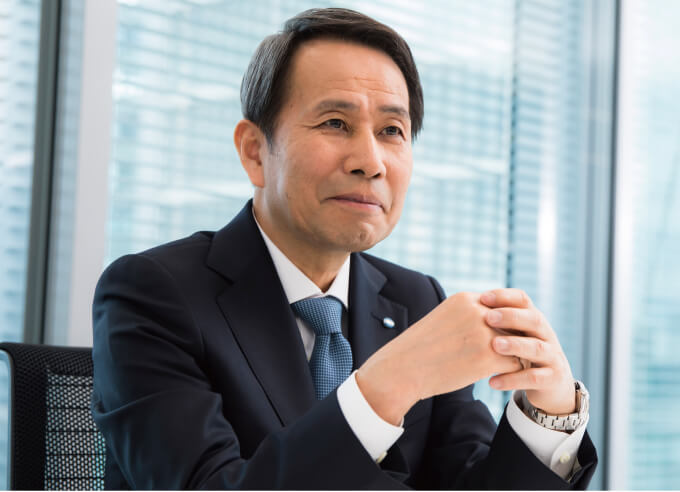
Strengthening our corporate brand by pursuing “genre-top in value”
One more key element to our drive to establish medium- and long-term growth is our corporate brand strength. As a digital company, we need to have strong brand power worldwide if we are going to fulfill our potential. Building a corporate brand is not done by spending billions of yen on advertising. Brand power comes from more than just raising name recognition. We need to expand our business worldwide and contribute to resolving social issues wherever we are. As we do that, customers everywhere will view our brand as vital to society, as deeply trusted, and as where they turn to for solutions. More specifically, our services must impress the professionals that use them, change how they work, and add new meaning to their work and their lives. Through that process, they will naturally come to feel that Konica Minolta is a company that they need and trust. I believe that is the essence of brand building.
We have been advancing a “genre-top strategy” since Konica and Minolta joined forces in 2003. Our original objective was to capture market share that would put us in the top-class worldwide in each of our product genres. As a manufacturer, of course it is important to continue honing our technical capabilities and product strength. However, what customers are really looking for is not just technology, products, or systems, but the value that arises when they use those elements to increase productivity and stimulate creativity. When we recognized this, we changed our objective from being the genre-top in products to being the genre-top in value.
This is the value that we call “customer value.” Since our business is mainly focused on BtoB rather than on BtoC, our customers are mostly companies. The image we have of for the final user of our products is the professional at the worksite and the person that is their customer. In this sense, our business is “BtoB-to-PforP.” We work intimately with professionals on their jobs at all sorts of worksites, including manufacturers, printers, office workers, and doctors and caregivers to provide new value through our products. That is where we want to supply the value, and we want to be the best at it — the “genre-top in value.”
We do not solely sell products, and we also do not sell pure IT services without products. We are a company that provides purpose to the work and lives of professionals and people through our products and services. I want to build a strong brand by contributing to that sense of purpose and earning respect and trust for Konica Minolta.
ESG activities and risk countermeasures
Strengthening our imaging IoT/AI personnel to execute our strategies,
acting with dynamism, and creating a corporate culture
that pursues challenges
The terms ESG (environment, social, and governance) and CSV (creating shared value) have become common in recent years, and it is widely considered essential for sustainable corporate management that companies to combine their business activities with addressing social issues. We have been combining the two since the merger of Konica and Minolta in 2003.
Early on we understand that reducing our carbon footprint would also reduce our costs. We also realized that sharing our environmental technology and expertise with our business partners and customers would multiply the benefits to such a degree that we committed to cutting CO2 emission below neutral to become carbon minus by 2050. When we seek to create new business, our fundamental policy to plan to grow in fields that contribute to solving social issues. Our new businesses address issues in many ways, such as by enhancing nursing care productivity in a graying society, improving health and the quality of life, and supporting a safe and secure society.
Nevertheless, well-intentioned business creation will be fruitless if the business execution cannot keep pace with the changes in the social and business environments. At the same time, digitalization is only going to accelerate those changes. AI and IoT will become increasingly ubiquitous, and robotics and 5G will undoubtedly impact a diverse range of industries. The biggest challenge for top management is to keep up with the changing business environment.
I believe it is critical to secure the right human resources to carry out our strategies. Our aggressive M&A around the world in the past few years and bringing in numerous personnel with top-level knowledge and expertise in the IT field have made our staff one of our Group’s biggest strengths. Part of our M&A strategy has been to bolster our personnel in areas where we have insufficient staff, such as in healthcare and moving image analysis management. We are methodically expanding our staff of data analysts and scientists skilled in using deep learning for behavior analysis and people who will play key roles, such as product owners, to advance the edge IoT platform strategies that will drive our business. At the same time, we are methodically bolstering our in-house education, hiring new employees, and bringing in new staff through M&A.
I also tell employees that one of the best ways to avoid business risk is to understand the company’s importance to society, think for yourselves, and take swift action. We put great faith in our 6 Values and believe that using them as a guide when proactively making decisions will enable us to take quick action when the environment changes. With each employee having a sense of ownership and generating dynamic ideas, we will create customer value that surpasses customer expectations. In such a rapidly changing environment, a corporate culture with this type of entrepreneurial spirit is a prerequisite to creating customer value and growing our business. Because of this belief, I think the increase in multidivisional bottom-up-type projects in the past two years where younger employees have been openly sharing their ideas has been wonderful for the company.
I also think it that creativity that is sparked by a clashing of perspectives is also extremely important. Discussions with colleagues that have different ways of thinking also bring out the best in each person. Promoting diversity has long been part of our corporate culture and, recognizing that it is one of our strengths, we decided to amplify it further. To symbolize this view, in April 2019 we changed the name of the Corporate Diversity Office to the Corporate Diversity & Inclusion Office. We feel that this change is in line with our efforts to promote inclusion and our belief that the diversity of our employees is one of our greatest strengths. We will continue to support the empowerment of the “individuality” of our staff members.
We also need one more element to accelerate the quickness of our response to changes in the business environment: we must break out of the closed innovation paradigm. The Japanese manufacturing industry struggling to overcome this and it has been an issue for us as well. However, there have been many times in the past several years during our numerous alliances and M&A that we have forged a single strategy for collaboration with companies that have different perspectives. As our five Business Innovation Centers around the world shows, we are constructing environments where different perspectives can come together, and I believe we are making steady progress toward more open innovation.
We will continue bringing together diverse perspectives and ways of thinking and fusing technologies to accelerate the creation of new value that contributes to solving social issues.
To our shareholders and investors
Committed to our dividend policy and
proactively returning profit to shareholders
Our ideal is for investors to own our stock because they support our efforts to grow the company from a medium- and long-term perspective.
We also seek to fulfill investor expectations to maintain a consistent dividend policy and to continually increase our dividend payment amounts despite temporary fluctuations in our business performance. We provide additional shareholder return by flexibly considering share buyback programs.
We maintained our an annual cash dividend payment at ¥30 per share for fiscal 2018, and plan to again provide an annual dividend of ¥30 per share in fiscal 2019. Konica Minolta will continue to seek out sustainable growth while living up to the trust of its shareholders and many stakeholders. I kindly ask for your continued support for the Group and understanding as we move forward.


